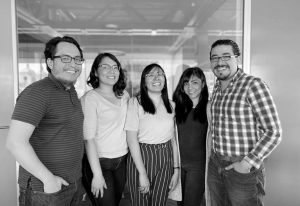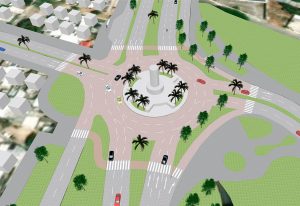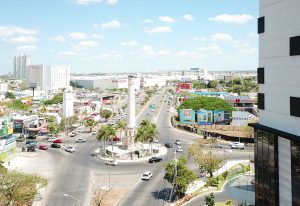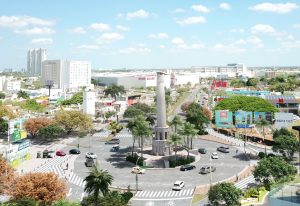Arquitectura|911
Don’t miss the interview with a|911, about his Fo experiences with urban mobility projects.
After developing different types of projects related to mobility, a|911 created its a|911 mobility division in 2016.
Its purpose is to generate comprehensive and sustainable projects that improve urban mobility through new methodologies and technologies hand in hand with different specialists in the area such as urban planners, architects and engineers who justify their implementation. The design of safe intersections, studies of multimodal traffic and pedestrian infrastructure, as well as public transport projects are the main drivers of the division.

Mobility division at a|911 Fotografía
Photography: a|911
WHAT ARE THE MAIN PRINCIPLES THAT A|911 IMPLEMENTS IN ITS URBAN MOBILITY PROJECTS?
When we receive a new project, we seek to carry it out in an integral way using the different areas of knowledge that define us as a|911, which are architecture, urban planning, landscape and mobility; Having different specialists in each area allows us to enrich the process and results of each project.
One of the most important principles is the design focused on pedestrian safety and non-motorized transport. In addition, in the technical part, we carry out the evaluation of the solutions through mathematical simulations that allow us to support in quantitative terms the different solutions that may be proposed in addition to making them visually possible. This allows us to provide quality and reliable projects to the different industries with which we collaborate.
CURRENTLY, WHAT IS THE BIGGEST CHALLENGE YOU FACE WHEN DESIGNING BIKE LANES IN
A METROPOLIS?
Although the integration of bicycle lanes to roads improves mobility in cities, the main factor that works against it is the culture of car preference.
At least in the last 100 years the automobile has been introduced through a commercial component that has made it an aspirational element; where people, instead of buying a car for ease of transportation, acquire it mostly to generate status; This becomes a vicious circle because cities, mainly in Latin America, have been built to function mainly for private vehicles, thus prioritizing the use of public space for a minority; therefore, it becomes complex to live or migrate to the new transport trend.
WHAT FACTORS ARE RELEVANT WHEN DESIGNING ROADS THAT ARE RESPECTFUL OF THE ENVIRONMENT?
At the time of generating the design of intersections and/or roads, we seek from the beginning to integrate green elements such as pedestrian shelter areas, vegetation that provides shade or pocket parks that give a complete sense of coexistence among all road users (pedestrians, cyclists, motorists); this in order to mitigate the possible negative impact of the ongoing project. For us as a team, it is relevant to preserve wildlife no matter where the location of the project is, which is why we give the greatest importance to our design considering the protection of existing vegetation and exhaust the possibilities in order not to eliminate it or, if necessary, to relocate it.

Roundabout
Illustration: a|911 a partir de PTV Vissim
WHAT IS THE IMPORTANCE OF INCLUDING VEGETABLE ELEMENTS IN AN URBAN MOBILITY PROJECT?
The landscape applied to urban mobility in recent years has played an important role in establishing a quality service that goes beyond the urban image, that is, the shade generated by the trees makes walking more pleasant and safer for pedestrians, in addition to reducing the sensation of heat due to its absorption and finally mitigating the negative impact of polluting emissions that can be generated by motor vehicles.
Another important factor is that noise pollution is reduced, the placement of trees or suitable plant barriers adjacent to transport corridors can reduce noise by up to 10 dB. One of the success stories that exemplifies the good practices of vegetation in roads is Gobernador José María Tornel street in the San Miguel Chapultepec neighborhood in Mexico City, where walkability becomes friendly due to the type of trees that are implemented on the road, they generate sufficient shade and the climate becomes mild most of the time. It is very important to promote the integration of green elements that increase the benefits to the environment and that, in turn, promote others to all users.
WHICH OF YOUR WORKS EXEMPLIFIES THE CONCEPT OF SUSTAINABLE URBAN MOBILITY?
In 2019 we carried out a study in Mérida, Yucatán, which consisted of evaluating the efficiency of a series of intersections. As a result, we obtained different designs. One of the cases that meets the concept of sustainable urban mobility is the proposal we made at the intersection located at the Las Haciendas Monument.
The diagnosis showed that the conditions for safe pedestrian crossings are zero, in addition to the fact that the waiting time to cross is very high due to the lack of vehicle control. According to the diagnosis, we proposed the traffic lights of the roundabout and channeled right turns to speed up the flow of vehicles, which will reduce the waiting time at each access point.

Current situation Las Haciendas
Fotografía: a|911

Las Haciendas proposal
Photography: a|911











